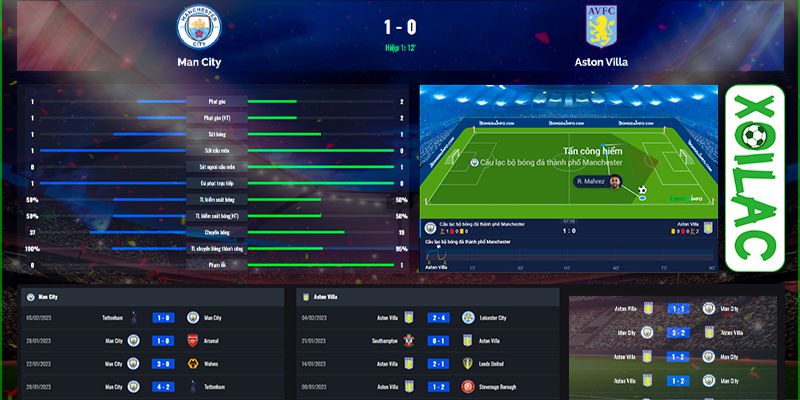Theo dõi tin tức bóng đá mới nhất hôm nay tại Xôi Lạc TV
Xem bóng đá tại Xoilac TV là sự lựa chọn hàng đầu của cộng đồng fan hâm mộ Việt, hãy truy cập vào bài viết này để hiểu được lý do vì sao?
Ngày 20/04/2024
Bạn là một fan hâm mộ bóng đá và đang tìm kiếm một địa chỉ phát sóng trực tiếp những trận đấu hấp dẫn? Bạn muốn cập nhật nhanh chóng những thông tin về lịch thi đấu, kết quả, bảng xếp hạng, thông tin soi kèo uy tín? Hãy truy cập ngay website của Xôi Lạc TV. Bởi chuyên kênh này sẽ có khả năng đáp ứng được toàn bộ nhu cầu kể trên của mọi người.
Truy cập link xem bóng đá tại Xôi Lạc TV chính xác
Xôi Lạc TV luôn tự hào là một trong số những kênh chuyên cung cấp link xem bóng đá trực tiếp hấp dẫn, đáp ứng mọi nhu cầu của khán giả. Cụ thể, các đường link được cung cấp trên website luôn đạt độ phân giải cao nhất, âm thanh sống động và chân thực nhất. Tuyệt đối không có tình trạng giật lag hay mờ nhoè trong suốt 90 phút thi đấu.
Bên cạnh đó, mỗi trận đấu đều sẽ được Xoilac ghim tối thiểu 3 link để dự phòng tình trạng quá tải. Nếu link gốc bị lỗi server và không mở được, bạn hãy chuyển sang link dự phòng để tiếp tục theo dõi đường bóng lăn.
Ngoài ra, người dùng cũng cần lưu ý tránh truy cập website giả mạo. Tình trạng lợi dụng danh tiếng của Xôi Lạc TV để lừa đảo, ăn cắp thông tin của người dùng đang trở nên phổ biến hơn bao giờ hết. Do đó nếu không phải link được cung cấp tại Xoilac thì mọi người phải hết sức thận trọng.

Những chuyên mục được cung cấp trên website Xôi Lạc TV
Xoilac luôn đứng ở vị trí đầu trong số những kênh phát sóng bóng đá hàng đầu tại Việt Nam. Dưới đây là những chuyên mục có sẵn trên hệ thống mà bạn có thể sử dụng:
Tin tức bóng đá:
Tin tức bóng đá mới nhất, nóng hổi nhất sẽ được Xôi Lạc TV cập nhật liên tục. Từ những giải đấu lớn trong nước và quốc tế cho đến các giải bóng đá phủi, bóng đá cỏ đều có sẵn.
Mọi người cũng sẽ biết được tin tức về tình trạng chấn thương của từng cầu thủ, thông tin chuyển nhượng, phong độ thi đấu, kỷ lục, danh hiệu, hậu trường,...của các đội bóng và cầu thủ yêu thích của mình. Bạn cũng sẽ được đọc thêm những phân tích, nhận định, chia sẻ, góc nhìn từ chuyên gia hay các nhà báo bóng đá uy tín để phục vụ quá trình cá cược sinh lời.
Video bàn thắng:
Xôi Lạc TV sẽ tổng hợp và cung cấp các video bàn thắng trong các trận đấu quan trọng. Nhờ vậy, nếu bạn không có cơ hội theo dõi 90 phút của trận đấu cũng vẫn được chiêm ngưỡng những khoảnh khắc đáng nhớ nhất của đội bóng mình yêu thích.
Không những vậy, các video bàn thắng của từng chân sút nổi tiếng, đẳng cấp thế giới như Cristiano Ronaldo, Lionel Messi, Kylian Mbappe, Erling Haaland cũng sẽ được cập nhật riêng. Qua đó giúp mọi người có thể tải về máy để xem offline hoặc theo dõi trực tiếp trên trang web.
Video highlights:
Xôi Lạc TV cũng mang đến cho người hâm mộ bóng đá Việt những video highlight của những trận đấu hấp dẫn. Bạn sẽ được xem lại những tình huống đáng chú ý như bàn thắng, cơ hội ghi bàn, pha phạm lỗi, thẻ phạt, solo,...Những video highlight này được phân chia theo từng cặp đấu và từng giải đấu lớn trên toàn cầu như Euro, World Cup, Champions League, Premier League, Bundesliga, La Liga, V-League,...

Đánh giá ưu, nhược điểm của website Xoilac tv
Trải qua quãng thời gian dài phục vụ khán giả, hãy cùng chúng tôi điểm qua một vài ưu điểm và hạn chế của website.
Ưu điểm
- Kênh tập hợp những đường link trực tiếp bóng đá chất lượng nhất trước giờ thi đấu chính thức 1 tiếng để các cổ động viên dễ dàng cập nhật.
- Tin tức được sắp xếp từ mới đến cũ để người dùng website dễ dàng tìm kiếm và theo dõi những thông tin về bóng đá.
- Các trận đấu được tường thuật bằng tiếng Việt, giúp người dùng dễ dàng theo dõi được diễn biến của trận đấu.
- Lịch thi đấu của từng giải sẽ được cập nhật chi tiết theo giờ địa phương.
- Tính năng xem lại trận đấu và các video highlights tổng hợp những đường bóng đáng chú ý được cập nhật thường xuyên.
- Tất cả những đường link được website cung cấp đều được kiểm duyệt chặt chẽ, đảm bảo an toàn cho người dùng.
- Hỗ trợ cung cấp bảng tỷ lệ kèo và các nhận định bóng đá giúp cược thủ tự tin hơn khi tham gia dự đoán kết quả.
Nhược điểm
Vấn đề bản quyền là trở ngại lớn nhất mà Xôi Lạc TV phải đối mặt. Tuy nhiên, đội ngũ nhân viên của kênh sẽ có những cách để khắc phục vụ vấn đề bằng cách thay đổi tên miền. Nhờ vậy, người xem dù ở bất cứ đâu đều dễ dàng theo dõi được trận đấu mà mình yêu thích mà không bị gián đoạn.

Xôi Lạc TV có vi phạm bản quyền bóng đá thật không?
Người đứng đầu kênh Xôi Lạc TV đã lên tiếng phủ nhận tin đồn vi phạm bản quyền phát sóng các trận đấu trực tuyến đang tràn lan trên MXH. Họ khẳng định rằng tất cả những trận đấu được phát sóng trên web đều được chi trả bản quyền và cung cấp đường link chất lượng nhất đến fan hâm mộ.
Trang web phát triển link xem từ nhiều nguồn tài nguyên khác nhau, đảm bảo chất lượng video luôn ổn định, âm thanh đạt chuẩn. Xoilac hiện đang lấy kinh phí từ việc đặt các banner quảng cáo để tiếp tục duy trì hoạt động. Do vậy, họ hoàn toàn có khả năng nhận được sự cho phép phát sóng bóng đá từ các giải đấu lớn.
Giải đáp một số thắc mắc từ người dùng Xôi Lạc TV
Rất nhiều người dùng đã gửi thắc mắc của mình về bộ phận chăm sóc khách hàng của website Xoilac. Trong phần bài viết này, chúng tôi sẽ tiến hành giải đáp chi tiết từng băn khoăn để mọi người hiểu rõ hơn về kênh.

Đăng ký sử dụng dịch vụ tại Xôi Lạc TV như thế nào?
Để sử dụng tất cả các dịch vụ được cung cấp tại Xôi Lạc, mọi người có thể đăng ký tài khoản trên trang thông qua di động hoặc website. Mọi người sẽ phải nhập thông tin cá nhân và mật khẩu để đăng ký. Sau khi đã được hệ thống phê duyệt, bạn sẽ được sử dụng ngay toàn bộ những tính năng có sẵn.
Bên cạnh đó, trang chủ của Xoilac cũng sẽ có những gói dịch vụ khác nhau cho mọi người lựa chọn sao cho phù hợp với thời gian đăng ký. Do đó, các fan hâm mộ thể thao dễ dàng lựa chọn được gói phù hợp với sở thích.
Xôi Lạc TV hiện có hoạt động nào?
Kênh của Xoilac hiện đang cung cấp các đường link theo dõi bóng đá trực tuyến được phát sóng với tốc độ cao. Trang đã có bản quyền của nhiều giải đấu lớn trong khu vực và trên toàn thế giới.
Bên cạnh đó, bạn có thể truy cập Xôi Lạc TV thông qua app điện thoại hoặc trên website cực tiện lợi. Thậm chí, bạn còn có khả năng để lại bình luận trực tiếp trong khi trận đấu đang diễn ra để trao đổi thông tin với những người có cùng chung đam mê khác.
Trận đấu kết thúc có thể xem lại hay không?
Xôi Lạc TV có hỗ trợ tính năng phát lại toàn bộ trận đấu. Do đó, bạn không cần lo lắng khi không kịp thời sắp xếp thời gian để theo dõi. Bất cứ trận đấu nào được phát sóng trên website đều được cập nhật lại, cho phép các fan hâm mộ được tận hưởng bầu không khí đầy căng thẳng và kịch tính mà bóng đá mang lại.

Kết luận
Như vậy, những thông tin chi tiết nhất về Xôi Lạc TV đã được chúng tôi tiết lộ trong bài viết này. Do đó, để nhanh chóng theo dõi được tin tức thể thao mới nhất và theo dõi những trận đấu hấp dẫn, hãy nhanh chóng truy cập vào nền tảng này ngay hôm nay.
